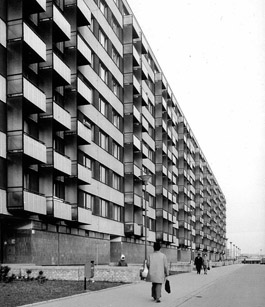
Panel buildings addressed the housing crisis and still attract buyers today due to their price
 |
According to him, panel buildings have many disadvantages, such as poor sound insulation and lack of parking. However, they are usually located in areas with developed civic amenities and close to transport infrastructure. Hána also pointed out the lower prices compared to developer projects or older brick buildings as an advantage. Due to the general rise in housing prices and insufficient supply, panel apartments are also becoming more expensive. According to Deloitte, in the third quarter of last year, the average price of a panel apartment in Prague and regional cities was 41,100 crowns per square meter. This was 30 percent cheaper than apartments in developer projects.
Panel construction ended in Czechoslovakia at the turn of the 80s and 90s with the change of regime. From the 50s until 1991, about 80,000 panel buildings with 1.2 million apartments were constructed in the Czech Republic. In 1989, more than three million people lived in them. Housing construction peaked in the mid-70s when over 70,000 apartments in apartment buildings were completed. According to data from the Czech Statistical Office, the intensity of housing construction at that time was eight to nine apartments per 1,000 inhabitants per year, significantly exceeding the level of construction in most European countries.
Standardized panel estates significantly changed the character of cities. Examples include Prague's Jižní Město, Brno's Bohunice, Poruba in Ostrava, Severní Předměstí in Pilsen, Moravské Předměstí in Hradec Králové, the Máj estate in České Budějovice, or Severní Terasa in Ústí nad Labem.
The tallest panel building was completed in 1980 in Prague's Jižní Město. It measures 81 meters and has 23 floors. The longest panel building, built in 1975, is located in Prague's Bohnice on Zelenohorská Street. It measures 300 meters.
"After the cessation of centrally planned construction, a vacuum occurred in the Czech residential market, which was only resolved by the 1994 Apartment Ownership Law. In the 90s, it was not yet possible to buy an apartment, mainly due to the underdeveloped market. It was easier to build your own house, leading to the so-called satellites beyond the large cities," added Hána. According to the Czech Statistical Office, housing construction was at its lowest in 1995, when the number of completed apartments fell by 87 percent compared to 1975. Only after that did housing construction begin to revive slightly.
According to Hána, the launch of the housing market was made possible by the privatization of municipal and enterprise housing stocks, the development of housing projects, and after 2000, the development of the mortgage loan market. "We have shifted from one extreme of purely state or municipal construction to the other side, where nearly all housing construction is provided by private companies," stated Hána. As examples of the largest modern projects in Prague, he mentioned Zelené město, Trojský vrch, Javorová čtvrť, Prosek park, Metropoli Zličín, Rezidence Garden Towers, or the Jahodnice residential complex.
The English translation is powered by AI tool. Switch to Czech to view the original text source.
0 comments
add comment
Related articles
0
29.03.2021 | Study: Panel apartments in the Czech Republic increased in price by 19.5 percent year-on-year
0
28.06.2020 | Flats in panel houses are a quarter cheaper than brick ones.
0
28.06.2020 | In panel houses in the Czech Republic, three million people currently live
0
30.04.2018 | The exhibition about panel houses is being extended, competing for the museum award
0
29.01.2018 | The exhibition focuses on the history, form, and reasons for the emergence of panel houses
0
22.01.2018 | The housing estates have their advantages and, according to experts, belong to the history of architecture
0
29.06.2016 | In Prague, interest in panel apartments is growing
0
28.06.2015 | Paneláky - once gray rabbit hutches, now colorful affordable housing
0
23.04.2008 | The main problem of panel houses in the Czech Republic is high thermal losses












